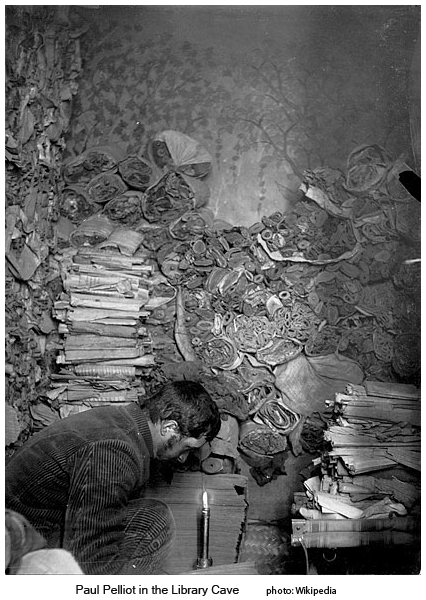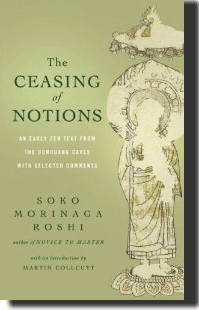
translated into English by Ven. Myokyo-ni (Irmgard Schloegl) and Michelle Bromley
commentary by Soko Morinaga Roshi
Introduction by Martin Collcutt
Wisdom Publications, Boston, in association with The Zen Trust and the Buddhist Society, London, 2012
pp 121
reviewed by Vladimir K.
In 1900, a Chinese Taoist, Wang Yuanlu, self-appointed guardian of a series of caves 25 kilometres southeast of the small city of Dunhuang, Gansu Province, began to clear away the sand blocking a cave and made one of the most important and astonishing Buddhist archaeological discoveries in China.
Commonly known as the Dunhuang Caves (but officially titled the Mogao Caves, a UNESCO World Heritage Site), the site is a series of over 700 caves that had been first created in the early fourth century CE as a religious site, originally as a meditation site for Buddhist hermits. Later the area developed into a complex of shrines, temples and storage areas. As nearby Dunhuang was an important centre on the fabled Silk Road, the caves became a destination for Buddhist pilgrims from throughout the ancient world. Elaborately painted, the cave complex was expanded through funding by wealthy patrons, Chinese and foreign, and pilgrims, military officials, and nobility. Although the cave complex flourished for centuries, by the Yuan Dynasty (1271–1368), construction of new caves ceased as the Silk Road began to lose its importance as a trade route. Some of the caves were used as storage areas for manuscripts and paintings and walled off, perhaps to protect their contents. Dunhuang became de-populated and the caves were forgotten by the outside world.

What Wang Yuanlu discovered was a small walled-off cave of some 500 cubic feet (14 cubic meters) crammed full of manuscripts and paintings. The manuscripts in this cave (which became known as the Library Cave) date from 406 to 1002 CE and are written not only in Chinese, but also Tibetan, Uighur, Sanskrit, and Sogdian, reflecting the cosmopolitan nature of Dunhuang as an important trade centre. Many of the valuable manuscripts were sold to European archaeologist explorers, especially Sir Aurel Stein and Paul Pelliot in 1907 and 1908 respectively. Some 40,000 manuscripts, paintings and printed documents on paper and silk were eventually unearthed in the Library Cave and many were scattered throughout institutions world-wide. In 1994, The International Dunhuang Project was established to reunite the works through high-quality digital photography and to make the works available to the world via the internet. The Ceasing of Notions is one of the texts uncovered in the Library Cave.
Buddhist scholar, John McRae, attributes this text to the Ox-head School of early Chan. McRae explains that research of the Ox-head School (named after the mountain Mount Niu-t’ou, Ox-head Mountain), has, until recently, been almost entirely devoted to the study of this text, the Chüeh-kuan lun (Jue-guan lun) which was rediscovered through the publication in 1935 of D. T. Suzuki’s Shōshitsu issho (Lost Works from Bodhidharma’s Cave). In all, there are six extant Dunhuang manuscripts of this text, all of which were published by Suzuki in 1945 and then by the eminent Japanese scholar Yanagida Seizan in 1970. The authorship of the text is in dispute. McRae notes that the text, which he dates as sometime after 750, has been variously attributed to Shen-hi, Bodhidharma, Niu-t’ou Fa-jung, the legendary figurehead of the Ox-head School or perhaps by someone else later in the Bodhidharma tradition. Regardless of the authorship, the text is an important component in understanding the development of early Chan and the subsequent development of Japanese Zen.
The text is an early example of the creativity of early Chan writing. It is structured as a dialogue between master and pupil but is obviously a fictional encounter. Highly structured as it is, it may be, as McRae notes in his essay, The Antecedents of Encounter Dialogue in Chinese Ch'an Buddhism, “intended to model ideal teacher/student interactions and may in fact have resembled to some degree actual exchanges that took place between living meditation masters and practitioners.” McRae translates the title as Treatise on the Transcendence of Cognition and the two individuals, master (Ju-li hsien-sheng; Ruli) and disciple (Yüan-men; Yuanmen), as’ Professor Enlightenment’ and ‘Conditionality’. The current volume under review has the title The Ceasing of Notions and uses the Japanese names Emmon and Master Nyuri. This text is translated by Venerable Myokyo-ni (Irmgard Schloegl, 1921 – 2007) and Michelle Bromley from earlier versions in German, English and Japanese (but notably, not Chinese).
The master in the text tries to lead the student from his notions of delusions and clinging, seeing everything in a dual way, to a true understanding of Chan. Master Nyuri constantly points to the student’s errors in seeing things as a duality and not recognizing the emptiness in all things, including his questions. Throughout the dialogue, the student fails to understand the master’s teaching until the very end when he becomes ‘enlightened’, “finally breaking through to the pure, non-discriminating illumination of śūnyatā”. (McRae: 217) This translation is liberally annotated by Soko Morinaga Roshi, notes which are most useful in penetrating what can be obscure in the master’s replies. Furthermore, there is a short selection from Morinaga’s biography, Novice to Master: an ongoing lesson in the extent of my own stupidity. This entire volume is just 121 pages of which the main text is only 77 pages, the rest being excerpts from Morinaga’s biography, two pages “About the Authors and Translators” and the Introduction.

As the introduction says, the purpose of this translation is not to adhere to “severe literalness or heavy scholarly apparatus” (p 3) but to make the text accessible to modern students of Zen. The introduction goes on to point out that the “Chinese Chan terms and personalities are given in their Japanese readings”, ostensibly “in the interest of accessibility” (p 4) but I fail to see how the Japanese names are any more “accessible” than Chinese renderings. It is one thing to use the Japanese rendering of names in Romaji when discussing Japanese topics but quite another to perpetuate the Japanization of what we know as Zen. It is time the cultural heritage of Chinese Chan was acknowledged and respected through the use of the official Pinyin transliteration, a system in use in the People’s Republic of China, Taiwan, Singapore, Malaysia, the United Nations and many international institutions. Although I recognize the important role played by Japanese teachers in bringing Zen to the West, it is time to stop usurping Chinese culture through the use of Japanese names and begin to learn the proper names and titles of the ancient Chinese masters.
Although this is a very slim volume, it is sure to provide plenty of food for thought for both experienced Zen students and new comers alike. The translation is eminently readable and Morinaga’s commentary is useful and enjoyable to read. I recommend this to all who wish to learn more about the early teachings of Chan and I commend Wisdom Publications on a delightful volume that I am sure will be read more than once by myself.
References and Further Readings
McRae, John R. (1983) The Ox-Head School of Chinese Ch'an Buddhism; in Early Ch'an to the Golden Age in Studies in Ch'an and Hua-Yen, ed: R. M Gimello, P. N. Gregory, The Kuroda Institute, Studies in East Asian Buddhism, No. 1, University of Hawaii Press, Honolulu
____________
(2000) The Antecedents of Encounter Dialogue in Chinese Ch'an Buddhism; in The Koan: Texts and Contexts in Zen Buddhism, ed: S. Heine, D. S. Wright, Oxford University Press,New York